
CSA Week 23: 2022 Main Season Registration is Live!
News
Expected Harvest
Sweet Potato Time!
by Farmer Dana
Sweet Potato Time!
by Farmer Dana
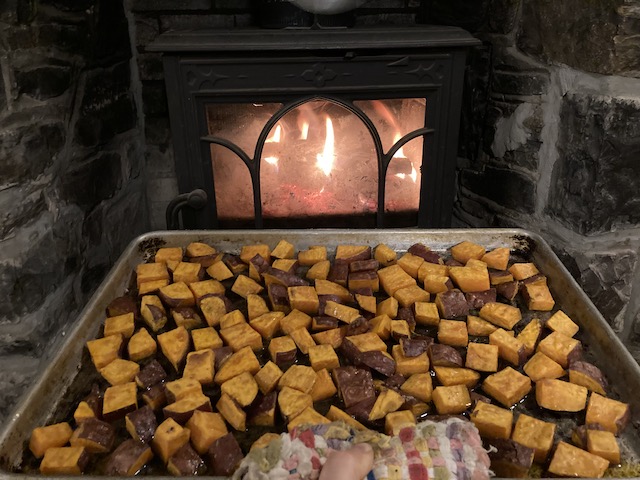
Roasted sweet potatoes and a warming fire; it must be fall, finally.
Harvest #23 (Week A) should include sweet potatoes, celery, beets, mini head lettuce, radishes, kohlrabi, turnips, tomatoes, romaine lettuce, sweet peppers, leeks, kale, arugula, radicchio, fennel, hot peppers, shishito peppers, and cured garlic. Some items will be a choice. U-pick should include flowers and herbs.

Notes From The Field
Wrapping It Up
by Farmer Derek
Wrapping It Up
by Farmer Derek
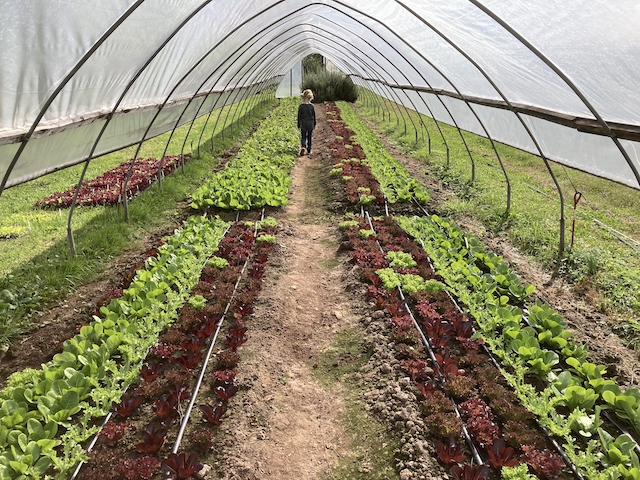
Hoop House greens (and reds).
The time for outdoor soil disturbing tractor work is concluding. We don't want to unnecessarily leave any soil exposed over the winter months and our window to sow and establish a cover crop is shutting. We sow a mix of buckwheat and oats in August and September then switch to rye, which germinates and tolerates colder weather better, in October. The oats and buckwheat will grow a lot during the warmth of late summer and early fall but will die back over the winter and enable spring planting of produce crops whereas the rye will overwinter and grow tremendously in the spring which in turn will require a substantial amount of time to break down before we can plant produce, typically in July and August in those locations. All cover crops will scavenge for nutrients, harness the sun's energy, and add soil fertility and contribute to the soil food web for the benefit of next year's crops. They also add a nice and tidy element to the farmscape.
We have one more outdoor planting to make this year: the 2022 garlic! These raised beds are just about ready to go (you never know how long soil could stay wet this time of year) but will be re-shaped one final time before we plant the cloves on or around election day. After planting we'll apply a thick layer of straw mulch to insulate and protect the soil and cloves over the winter so they don't frost-heave out of the ground. The straw also suppresses weeds and retains moisture and adds plenty of organic matter. We'll probably require some help from members so if you still have hours to contribute for your discount your help would be appreciated! Also on this subject, over the next couple of weeks we'll spend workshift time in the barn splitting bulbs into cloves from the comfort of a chair (an easy-on-the-body event).
Last week we planted the final three beds of greens in the hoop tunnel and this coming week we should plant the five beds in the greenhouse, ending seven months of regular transplanting. It also ends eight months of seedling maintenance with daily watering of transplant trays. Once crops are in the ground in the tunnels they'll need added water every week or so until late November or whenever freezes become common then we'll switch to every two weeks.

2022 Main Season Registration Open!
by Farmer Dana
by Farmer Dana
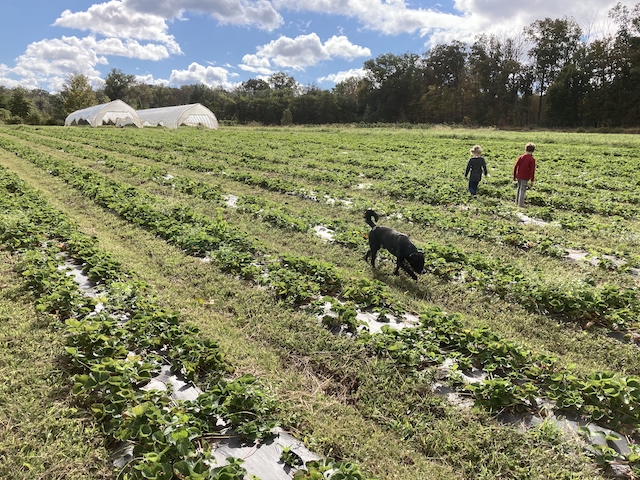
Strawberries freshly mowed and gathering sunlight and strengthening roots for a good fruit crop next summer.
Registration is now open for 2022 Main Season CSA! For the first time since 2008 we are modestly increasing our share cost. Share prices will rise an average of $2.50/week. However (!) prices will not officially increase until 1/1/22 so if you register and pay in full by 12/31/21 you will benefit from last season's rates.

Workshifts This Week (10/18/21)
by Farmer Derek
by Farmer Derek
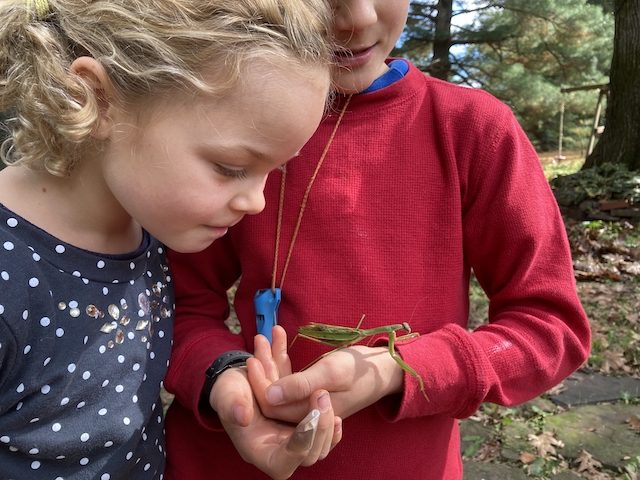
Saying 'goodbye' and 'thank you' to this praying mantis before it departs for the next phase soon.
Legit wonderful fall weather is here! Work opportunities will only be available for a few more weeks.
Workshift policy reminder: If you signed up for a share with work discount your share cost is reduced by $15 per worked hour (8 for Full, 6 for Medium, 4 for Half). If you're unable to satisfy the work requirement for the discount please remit a check to cover the share cost.
This week's workshift schedule:
- Tuesday 10/19 10am-12pm
- Wednesday 10/20 10am-12pm
- Friday 10/22 10am-12pm
- Sunday 10/24 8-10am
Please bring gloves, water, a hat, and sturdy shoes! We meet under the large red maple at the end of the barn by the pick up room.

Colors of Fall
By Linda Dansbury
By Linda Dansbury
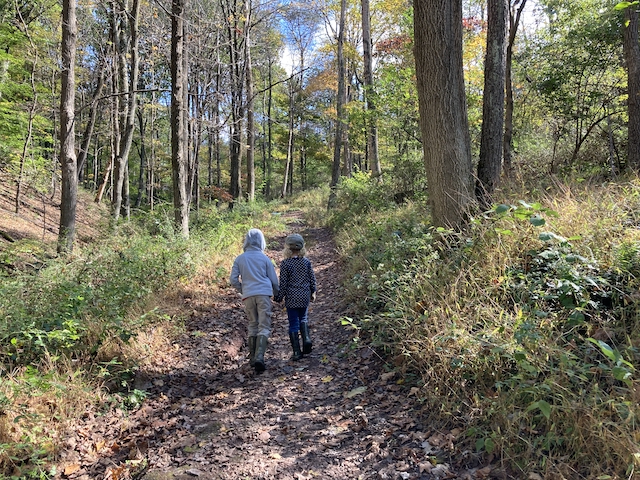
Sunday hike at Thomas F. Breden Preserve at Milford Bluffs, NJ.
As I write this, it seems fall has finally arrived to stay. I love the change of seasons and am enjoying my big, warm sweatshirt this morning. We are not receiving anything truly new or unusual this week, but I do have a few tidbits to share:
Peppers - Over the years I have marveled at the fact that even though peppers are a summer crop and flourish in hot weather, it is not until the fall that they show their true "colors". Peppers are beautiful as they fully ripen into bright shades of yellow, orange and red - and most importantly, the flavors are so, so sweet this time of year. I grow my own and have a bounty along with our farm share. Did you know peppers freeze really well? I have found the best way is to cut them into quarters lengthwise, remove the seeds and lay flat on a cookie sheet to freeze. Once frozen, place in a freezer bag or other airtight container. To use later, I find it easiest to chop them while they are still partially frozen. Add them to soups, chili or salsas. I also freeze hot peppers, but for them I just place in a bag in the freezer and remove as needed all winter long.
Fennel - I like this versatile veggie in the fall/winter months because my favorite way to prepare it is to braise it until meltingly tender. Brown slightly in a skillet in a bit of olive oil and/or butter. If you want, add minced onion, shallot or thinly sliced leek. Add wine and water to cover and a bay leaf. Simmer gently until most of the liquid is evaporated and the fennel is tender, about 20 minutes. Serve with a nice piece of fish such as salmon or halibut, or with lamb. I also love to add fennel to the pot when I cook lentils. The method is similar - I add fennel and some type of onion and minced carrots. Brown a bit then add lentils and water or broth and a bay leaf. When the lentils are tender, the veggies will be as well.
Cauliflower - our veggies are all organic, and although this healthy environment of the farm for the most part keeps insects to a minimum, check the cauliflower for cabbage worms when you get it home - they cause the quality of the veggie to degrade quickly.
All of the veggies above are delicious roasted - it is so fun and delicious to mix the beautiful colors together: peppers, cauliflower, leeks, potatoes/sweet potatoes, radishes, beets, kohlrabi, etc - the combinations are almost limitless. Make sure the pieces are cut about the same size so they are finished at the same time - I sometimes add the peppers and leeks a little later than the other veggies so they don't char too much.
Peppers - Over the years I have marveled at the fact that even though peppers are a summer crop and flourish in hot weather, it is not until the fall that they show their true "colors". Peppers are beautiful as they fully ripen into bright shades of yellow, orange and red - and most importantly, the flavors are so, so sweet this time of year. I grow my own and have a bounty along with our farm share. Did you know peppers freeze really well? I have found the best way is to cut them into quarters lengthwise, remove the seeds and lay flat on a cookie sheet to freeze. Once frozen, place in a freezer bag or other airtight container. To use later, I find it easiest to chop them while they are still partially frozen. Add them to soups, chili or salsas. I also freeze hot peppers, but for them I just place in a bag in the freezer and remove as needed all winter long.
Fennel - I like this versatile veggie in the fall/winter months because my favorite way to prepare it is to braise it until meltingly tender. Brown slightly in a skillet in a bit of olive oil and/or butter. If you want, add minced onion, shallot or thinly sliced leek. Add wine and water to cover and a bay leaf. Simmer gently until most of the liquid is evaporated and the fennel is tender, about 20 minutes. Serve with a nice piece of fish such as salmon or halibut, or with lamb. I also love to add fennel to the pot when I cook lentils. The method is similar - I add fennel and some type of onion and minced carrots. Brown a bit then add lentils and water or broth and a bay leaf. When the lentils are tender, the veggies will be as well.
Cauliflower - our veggies are all organic, and although this healthy environment of the farm for the most part keeps insects to a minimum, check the cauliflower for cabbage worms when you get it home - they cause the quality of the veggie to degrade quickly.
All of the veggies above are delicious roasted - it is so fun and delicious to mix the beautiful colors together: peppers, cauliflower, leeks, potatoes/sweet potatoes, radishes, beets, kohlrabi, etc - the combinations are almost limitless. Make sure the pieces are cut about the same size so they are finished at the same time - I sometimes add the peppers and leeks a little later than the other veggies so they don't char too much.


